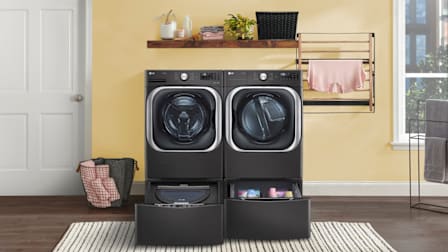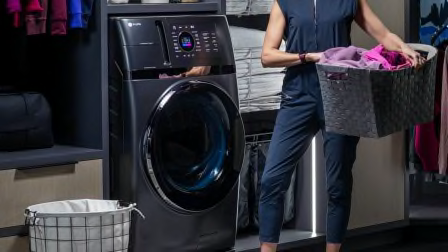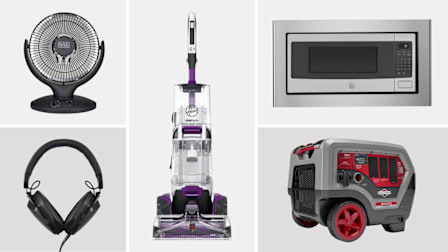A Rookie's Guide to Laundry
Nine laundry-day lessons from a guy who once washed a leather jacket (and who knows better now)

Time to come clean. There was a time in my life when I was a living, breathing, laundry cliché: A single guy who mixed whites and darks with abandon, who didn’t know "delicates" from a pair of dungarees, and who thought "permanent press" was a complex NFL defense.
You might be where I was. A college student, career climber, confirmed bachelor, or divorced dad. But whether you’re a pajama lounger like The Dude from “The Big Lebowski” or a high-fashion laundry lunatic like Patrick Bateman in “American Psycho”—or, hopefully, somewhere between these extremes—I can help you ramp up your game. I’ve witnessed the damage people can inflict on washing machines, dryers, and clothes. I’ve survived college roommates and mountains of dirty, smelly laundry. I’ve been there, and I’m here now to clear the air.
Is this guide exclusive to single guys? Of course not. Anyone can be careless about clothing care, and I won’t presume that marriage suddenly makes a person learn laundry. The information that follows can help any laundry novice handle the chore with ease. What might be obvious to some may be revelatory for laundry bunglers too embarrassed to admit they’ve washed a leather jacket. (Don’t do that, by the way. Not even if you’re a college kid trying to wash away the smell of a smoky bar.)
Sure, I’ve made my laundry mistakes. But since then, I’ve built up my personal store of washday wisdom by picking the brains of CR’s test engineers, chatting with experts, exploring washer and dryer settings, and decrypting appliance manuals. Now I can confidently say that I know exactly how to do laundry the correct way. Here are nine lessons I’ve learned on this journey, starting with the basics.
Lesson 1: Read Your Manuals
I know, I know. Dig ’em out of your junk drawer or search for a PDF online. Every washer and dryer is different, and yours may have features you’re not aware of. Did you know you can control some washers and dryers with your smartphone? Or that you can program some washers to delay the start time so the load starts when the dishwasher finishes its cycle?
Today, AI-equipped washers can sense fabric types, soil levels, and load sizes (automatically adapting water levels and dispensing detergent). And AI-equipped dryers can similarly detect fabric types and load sizes, as well as moisture (adjusting temperature and drying time accordingly). Washing and drying clothes is easier than ever if you know what your machines can do.
Lesson 2: Don’t Blow Up Anything (Safety Comes First)
Some of us imagine casually walking away from explosions like action movie heroes. But in the laundry room, safety rules. Those occasional headlines about exploding washers and dryer fires remind us that these are complex machines. So handle them with care. Here are a few basic tips for safe operation.
Lesson 3: Separate Your Clothes
You’ll be sorry if you wash your new red Air Jordan sweatshirt with your white work polo—unless you like faint pink polos. Mixing colors can bleed dye into other clothes, especially in hot water. And mixing fabric, like jeans and less durable cottons, causes friction that degrades clothes and releases microfibers into waterways. So take these steps:
Separate clothes by type—cottons, delicates, denims, etc. This is gentler on clothes, prevents fiber fallout, and keeps your clothes looking fresher longer.
Wash darks and whites only with like colors, or the whites will inevitably lose their brightness.
Wash abrasive jeans separately and rarely (only to refresh them). Care labels usually recommend turning jeans inside out to protect the color and finish.
“I recommend reviewing care labels, especially when you buy something new,” says Rich Handel, CR’s lead test engineer in the laundry lab. “They have tiny print to guide you, but also cool symbols that are easy to follow once you decode them.”
Lesson 4: Don't Overload the Washer
Shoving 10 towels into a washer just prevents them from circulating during the wash, especially in top-load agitator washers (those center-post machines that scrape our knuckles while loading). An overloaded washer cleans poorly and usually leaves excess residue on your clothes, which can cause itchiness or rashes, especially if you have allergies or sensitive skin.
Generally speaking, leave room for your clothes to swish around for better cleaning. “The clothes need some room to move around to allow the water-detergent solution to circulate and then the water to rinse away the detergent,” Handel says.
Large-capacity washers (4.5 cubic feet or more) can handle your oversized comforters. High-efficiency models (HE) and front-loaders are generally bigger (up to 5.8 cubic feet), with more than enough space to effectively wash bulky towels or multiple pairs of jeans. If you have an oversized load that doesn’t fit in your machine, consider a trip to a laundromat.
Lesson 5: Pour Only a Shot of Detergent
Today, most laundry detergents are concentrated—thick, like a pint of Guinness. So go light. Excessive detergent becomes a hangover pollutant that doesn’t go down well for your clothes, your wallet, or Mother Earth. Plus, it can leave detergent streaks, stains, or an itch-triggering film on your clothes.
“If you overdose on concentrated detergent, modern washers compensate and use more water to clean your clothes,” Handel says. “That means extra detergent-laced water dispersed into water systems. And you’ll end up with higher water bills and buying additional detergent unnecessarily.”
Here’s what Handel recommends:
Use the recommended amount, which is typically 1½ ounces for a normal load. Use twice as much for large loads or very soiled clothing. But never eyeball it. Ignore the faint lines of the detergent bottle measuring cup. Instead, raid your cocktail cabinet for an extra shot glass or jigger to measure and pour the correct amount of detergent into your washing machine dispenser. A full shot glass is about 1½ ounces.
Add powder detergent, pods, or scent beads to the drum before you load clothes so they dissolve better in water. Tossing them in on top of your load undercuts your cleaning efforts.
Never use the washer dispenser’s detergent level indicator, because it represents the maximum amount of detergent the washer can handle (too much!). In other words, don’t throw away your shots.
Skip fabric softener or use it sparingly because it’s generally a waste of money, Handel says. It can also irritate sensitive skin, leave residue, limit your towels’ absorption, and gunk up your washer’s sensors.
Lesson 6: Fight Stains Fast
Drips, splashes, and spills are inevitable, especially when you’re wearing white or crave olive oil as much as I do. So keep a top-rated stain-fighting detergent or spray at the ready. Most stains can be cleaned if you act fast. The sooner they’re treated, the easier they are to remove.
Pretreat those olive oil splatters with a laundry stain remover or a dab of detergent before washing. Let it set in for a few minutes. Inspect the garment to ensure the stains are gone before drying. Dryer heat can set them like greasy bull’s-eyes if they aren’t fully removed.
Lesson 7: Don't Get Into Hot Water
Unless, that is, you need to. Hot water kills germs, cold water is eco-friendly, and warm water is a safe choice. Temperature settings should be dictated by the type of fabric, colors, or stains. Hot water is typically recommended for some stains, as well as heavily soiled clothes, whites, washcloths, towels, and even sweaty workout clothes. But review the care label first because it might not be suitable for certain fabrics and stains (like ice cream or mustard).
Hot water usually ranges from 120° to 140° F. That’s hotter than Death Valley in August. Germy towels can be a health hazard. To stave off contaminants and potential infections, Handel and the American Cleaning Institute recommend washing towels in hot water after three to five uses and hanging them up to dry in between. But even hot water isn’t enough, according to Charles P. Gerba, PhD, a virologist who has studied contamination in hand towels. He suggests using an antimicrobial laundry sanitizer to kill odor-causing bacteria and prevent cross-contamination.
Warm water is the best option for washing colored clothes, regardless of the fabric type. It’s ideal for natural fibers like cotton and denim because it reduces shrinking, wrinkling, and fading. The Department of Energy says switching from hot to warm water can cut a load’s energy use in half.
Washing with cold water will save you even more. According to the American Cleaning Institute, cold-water washing is a “win-win for the wallet and wardrobe,” preserving the quality and longevity of clothes, protecting them from fading and shrinking, and saving about $200 per year on electricity bills compared with hot water.
Lesson 8: Take the Cycles for a Spin
Modern washers can offer up to 14 settings—far more than most of us need (like TV channels). But explore beyond the default normal cycle for more efficient cleaning. Here’s a rough breakdown of four typical cycles and when to use them:
Regular/normal cycle: Recommended for soiled whites, socks, underwear, and towels, this setting agitates clothes faster and uses more heat than gentler options.
Permanent press: This casual setting mildly agitates in lower temperatures and injects cool water before spinning to prevent creases and wrinkles. It works best for clothes that are often dry-cleaned, such as colored clothing, slacks, and button-down shirts.
Delicate cycle: The delicate cycle puts less stress on fabric—like wool sweaters or the bright orange dashiki that collects dust in my closet—using cold water and light agitation while washing at 65° to 70° F, preserving fashion relics for many years. A gentle cycle also typically means less microfibers draining with washer wastewater.
Soak cycle: If you’re a Tough Mudder competitor, this cycle might wipe the slate clean. It’s a prewash setting that loosens dirt or grime before the main wash. It’s ideal for mechanics, farmers, construction workers, recreational weekend warriors, and athletes who sweat for a living.
Lesson 9: Dry Right
Dryer settings are simpler than washer settings. Here’s a quick tour:
Automatic dry is an energy-efficient option (compared with timed drying) that automatically shuts off the machine when sensors detect that all clothes are dry.
Regular/heavy dry is the fastest and hottest setting, ideal for heavier fabric and bath towels.
Delicate dry relies on lower heat, so drying time is longer and drying is more gradual.
Permanent press dry works well for business-casual types (just like the wash cycle) and uses medium heat.
“Air Fluff” doesn’t really dry at all. Sans heat, it draws in room temperature air to freshen up stiff, delicate, or shrinkable items like linen pants, down coats, drapes, and pillows. It’s also useful for fabrics like wicking sportswear or soft-shell jackets that would be damaged by a heat setting. After all, I wouldn’t want you to ruin your coolest jacket because of a foolish laundry mistake. Take it from one who knows.




















